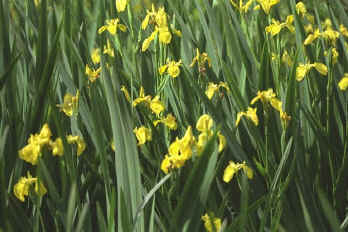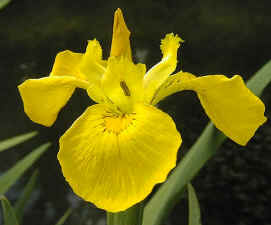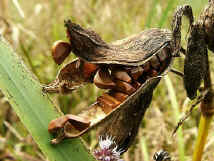Information on Selected Wetland Species
Yellow Iris
Iris pseudacorus L.

| Habitat | Water margins at the edge of lakes, ponds, streams and rivers, in damp pastures and meadows. Often an emergent plant in shallow water areas, generally where the water is less than 0.3m deep. Occurs in swamps and fens. It is tolerant of a wide range of soil types, but requires sites which are moderately fertile and which are moist or flooded for most of the year. Plants can tolerate occasional flooding with brackish water and periodic droughts. | |||
| Structure | Yellow Iris plants are perennials. The shoots may or may not die back in winter depending on the harshness of the weather. They have thick underground rhizomes. Plants contain poisonous glycosides and as a result are avoided as food plants by most herbivorous animals. The brittle leaves are easily damaged by trampling. Adaptations of swamp plants | |||
| Reproduction |
|
Flowering from June to August.
Conditions must be open and unshaded if plants are to successfully flower and set seed. Yellow Iris is one of the few aquatic plants to have evolved complex adaptations to insect pollination.The yellow tepals provide a platform for insects to land on. The dark yellow patch in the centre, surrounded by a zigzag line acts as a guide directing the insect towards the nectar source, which is inside the central flower tube. Any pollen already on the insect is brushed off onto the flower's stigma and new pollen may be deposited on the insect as it searches for the nectar. Flowers are usually pollinated by long-tongued insects such as bumble bees. Flower Structure and Pollination. |
||
| Dispersal |
|
|||
| Geographical Range |
Widespread throughout Britain and Ireland and in Europe. Absent from northern Scandinavia and Iceland. Native to North Africa and in Asia. Present in N. America and New Zealand where it is now widely naturalised. | |||
Sources of Information
Aquatic Plants in Britain and Ireland. C.D. Preston and J.M. Croft. Harley Books, 1997.
British Water Plants. S. Haslam, C. Sinker and P. Wolseley. The Field Studies Council 1975 (1982 ed.)

